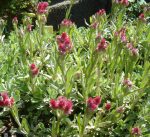
Also called cat’s foot and mountain everlasting, this semi-evergreen herbaceous perennial is native to western and north-central US where it grows in many different habitats. It is a member of the aster family, Asteraceae, that also includes daisy, yarrow, and lettuce. The ground hugging plant grows 4-12″ tall and forms basal rosettes of woolly, grayish leaves that are spoon-shaped and .4 to 1.5″ long. In early summer, slender, almost leafless stems bear clusters of small, rose-pink flowerheads . Male and female flowers are on different plants but most plants tend to be female. Plants self seed readily and spread by stolons. The flowers are attractive in dried arrangements and the plants are useful as a ground cover, in xeriscapes and border, as well as in rock, wildflower, and cutting gardens. The genus name, Antennaria, comes from the Latin word, antenna, meaning the yard on a sailing ship, and refers to the bristle-like hairs on the flower heads which resemble the antennae of some insects. The specific epithet, dioica, is the Latin word meaning having male and female reproduction organs on different plants. The varietal name, roseus, is the Latin word meaning rose-colored, and refers to the color of the flowers.
Type: Herbaceous perennial
Bloom: Clusters of pink flowerheads in early summer
Size: 4-12″ H x 12-18″ W
Light: Full sun
Soil: Average to lean, dry to medium moist, well-drained, slightly acidic
Hardiness: Zones 5-9
Care: Low maintenance
Pests and Diseases: None of significance
Propagation: Seed (self seeds), division in spring
Companion Plants: Creeping thyme, fairy foxglove, white sage
Photo Credit: Wikimedia Commons
.